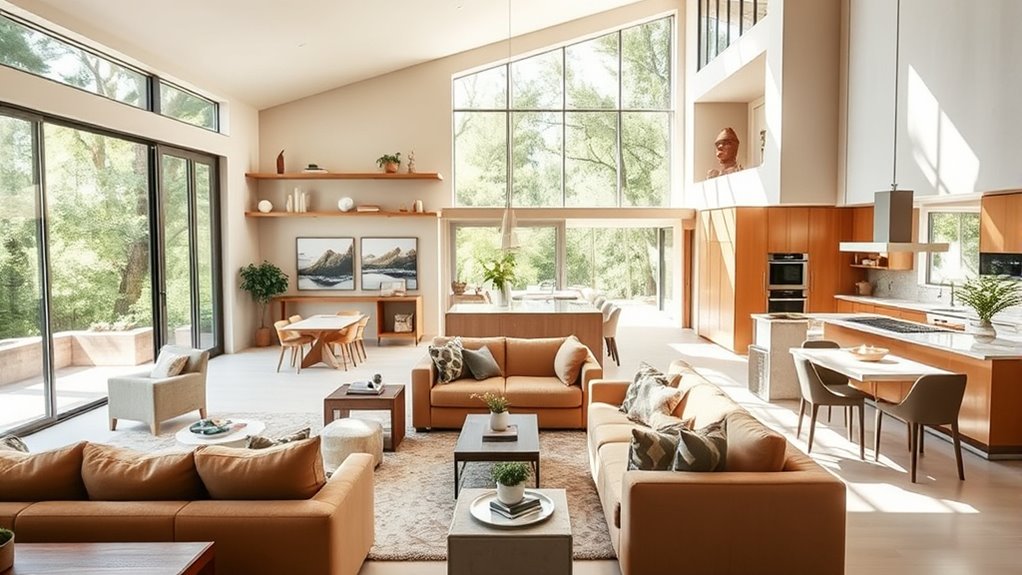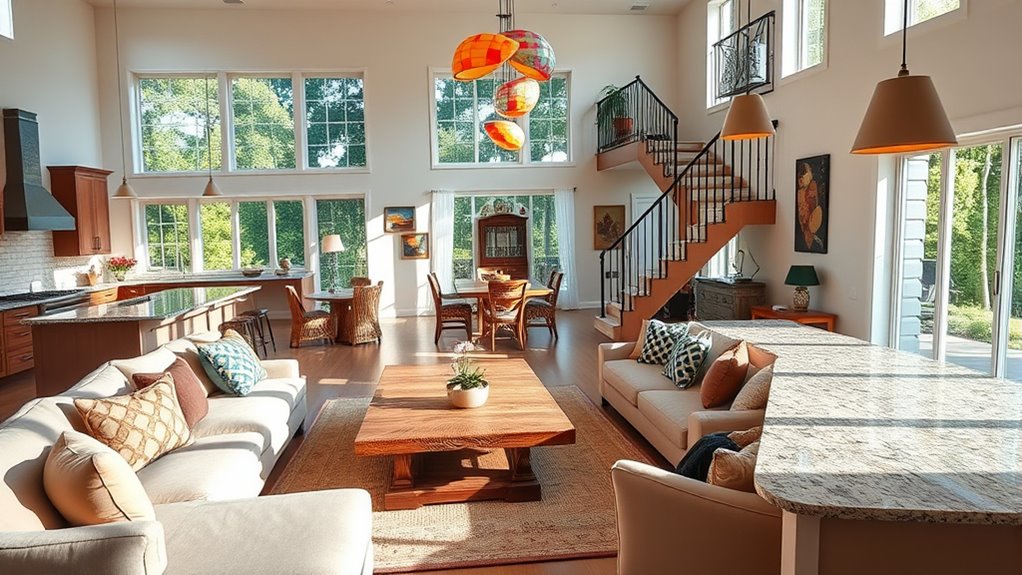To design effective multi-generational living spaces, focus on creating private zones like separate bedrooms or private entrances, and utilize screens or curtains for quick privacy. Incorporate flexible layouts with movable dividers, soundproof doors, and ample storage to reduce conflicts. Establish clear boundaries through household agreements and encourage open communication. By balancing shared and private areas thoughtfully, you’ll foster harmony. Keep exploring for detailed strategies to optimize your home’s design for multi-generational living.
Key Takeaways
- Incorporate private zones and separate entrances to ensure individual privacy within shared spaces.
- Use flexible dividers, screens, and movable elements to create adaptable private areas.
- Design dedicated bedrooms and personal retreat spaces for each generation’s needs.
- Implement smart storage solutions to maintain organization and reduce privacy conflicts.
- Establish household agreements and clear communication to set boundaries and manage shared amenities effectively.

Have you ever wondered how to create a home that comfortably accommodates multiple generations? Designing a space where everyone feels at ease requires thoughtful planning, especially when it comes to sharing amenities like bathrooms. A shared bathroom can be a practical solution, but it also raises concerns about privacy. To make this work smoothly, you need to incorporate effective privacy solutions that give each family member their own sense of personal space. Consider installing separate entrances or designated zones within the bathroom, so residents can use the space without feeling exposed. Adding curtains or screens can also provide quick privacy when needed, especially in more open-concept layouts. If possible, design the bathroom with multiple sinks or vanity areas, so several people can use it simultaneously. This reduces wait times and minimizes friction, making mornings less stressful for everyone.
Beyond the bathroom, you should think about overall layout and how to create boundaries that respect individual privacy. For example, compartmentalizing bedrooms or private living areas allows older adults or teens to have their own space within the home. Using soundproof doors or walls can also help reduce noise disturbances, which is essential for maintaining peace among different generations. Incorporate flexible dividers or movable screens in common areas to create temporary privacy zones when needed, whether for work, rest, or personal activities. Additionally, utilizing remote collaboration tools in shared spaces can facilitate work or communication for family members working or studying from home.
Create private zones with soundproof doors, flexible dividers, and dedicated spaces for peace and personalization.
Smart storage solutions play a vital role in multi-generational homes. Clutter can quickly diminish privacy and create tension; consequently, ample storage for personal belongings is essential. Each person should have designated drawers, shelves, or closets that keep their items separate and organized. This simple step helps foster respect for everyone’s space and prevents conflicts over shared areas. Additionally, clear signage or labels can guide family members to their personal zones, encouraging respect for each other’s privacy.
Finally, communication is key. Establishing household agreements about bathroom schedules, quiet hours, and personal boundaries can considerably enhance the living experience. When everyone understands and respects each other’s privacy solutions, shared spaces become more harmonious. With intentional design choices and open communication, you can turn the challenge of shared amenities into an opportunity for cooperation and closeness. Creating a multi-generational home that balances shared spaces with private retreats ultimately fosters a supportive, comfortable environment where multiple generations can thrive together.
Frequently Asked Questions
How Can Privacy Be Maximized in Shared Living Spaces?
To maximize privacy in shared living spaces, you should incorporate soundproof barriers between rooms to reduce noise transfer. Creating private outdoor spaces, like balconies or gardens, offers secluded areas for individual relaxation. Use room dividers or separate entrances to further enhance privacy. By prioritizing these elements, you guarantee everyone has personal space within the shared environment, making it more comfortable and harmonious for all generations.
What Are Cost-Effective Ways to Modify Existing Homes?
You can save money by focusing on simple home renovation ideas like repainting walls, updating fixtures, or adding temporary partitions for privacy. To stay within your budget planning, prioritize affordable modifications that improve functionality and comfort. Consider DIY projects to cut costs and explore secondhand stores for materials. These cost-effective strategies help you adapt your existing home for multi-generational living without overspending.
How Do Zoning Laws Affect Multi-Generational Housing?
Zoning laws considerably impact your ability to create multi-generational housing. Zoning restrictions can limit the types of structures you can build or modify, so you need to check local regulations for legal compliance. These laws may require permits or restrict accessory dwelling units (ADUs). To avoid issues, communicate with city officials, understand zoning restrictions, and guarantee your plans meet all legal requirements before making modifications.
What Safety Features Are Essential for Elderly Residents?
You should install safety features like home automation systems that simplify daily tasks and enhance security, such as automated lighting and emergency alerts. Make certain emergency preparedness by adding grab bars, non-slip flooring, and accessible exits. These features help elderly residents stay safe, independent, and comfortable. Regularly review and update safety measures to keep pace with their changing needs, giving everyone peace of mind in your multi-generational home.
How Can Cultural Differences Influence Design Choices?
You’ll find that cultural aesthetics and tradition integration deeply shape your design choices. By embracing diverse cultural aesthetics, you create a space that feels welcoming and respectful of everyone’s background. This might mean incorporating specific colors, symbols, or architectural elements that honor traditions. You actively adapt your design to honor cultural preferences, ensuring each generation feels connected and valued within the shared environment, fostering harmony and understanding through thoughtful, culturally-sensitive choices.
Conclusion
Creating multi-generational living spaces might seem complicated or cramped, but with thoughtful design, you can foster independence and closeness simultaneously. Embrace flexible layouts and private areas to guarantee everyone feels comfortable. Don’t let the idea of losing privacy hold you back—proper planning makes it possible to balance togetherness and personal space. With the right approach, your home can become a supportive haven for all generations, strengthening bonds while respecting individual needs.








